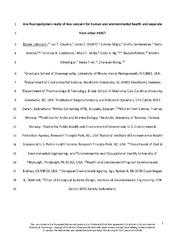Blar i forfatter Artikler, rapporter og annet (UB) "Herzke, Dorte"
-
Are Fluoropolymers Really of Low Concern for Human and Environmental Health and Separate from Other PFAS?
Lohmann, Rainer; Cousins, Ian T.; DeWitt, Jamie; Glüge, Juliane; Goldenman, Gretta; Herzke, Dorte; Lindstrom, Andrew B.; Miller, Mark F.; Ng, Carla A.; Patton, Sharyle; Scheringer, Martin; Trier, Xenia; Wang, Zhanyun (Journal article; Tidsskriftartikkel; Peer reviewed, 2020-10-12)Fluoropolymers are a group of polymers within the class of per- and polyfluoroalkyl substances (PFAS). The objective of this analysis is to evaluate the evidence regarding the environmental and human health impacts of fluoropolymers throughout their life cycle(s). Production of some fluoropolymers is intimately linked to the use and emissions of legacy and novel PFAS as polymer processing aids. There ... -
Correspondence regarding the Perspective “Addressing the importance of microplastic particles as vectors for long-range transport of chemical contaminants: perspective in relation to prioritizing research and regulatory actions”
Glüge, Juliane; Ashta, Narain Maharaj; Herzke, Dorte; Lebreton, Laurent; Scheringer, Martin (Journal article; Tidsskriftartikkel; Peer reviewed, 2022-01-27)Important clarifications regarding the long-range environmental transport of chemical additives contained in floating plastic debris are presented. -
Implications of Regurgitative Feeding on Plastic Loads in Northern Fulmars (Fulmarus glacialis): A Study from Svalbard
Tulatz, Felix; Gabrielsen, Geir Wing; Bourgeon, Sophie; Herzke, Dorte; Krapp, Rupert; Langset, Magdalene; Neumann, Svenja; Lippold, Anna; Collard, France (Journal article; Tidsskriftartikkel; Peer reviewed, 2023-02-22)Procellariiform seabirds like northern fulmars (Fulmarus glacialis) are prone to ingest and accumulate floating plastic pieces. In the North Sea region, there is a long tradition to use beached fulmars as biomonitors for marine plastic pollution. Monitoring data revealed consistently lower plastic burdens in adult fulmars compared to younger age classes. Those findings were hypothesized to partly ... -
Microplastic Fiber Emissions From Wastewater Effluents: Abundance, Transport Behavior and Exposure Risk for Biota in an Arctic Fjord
Herzke, Dorte; Ghaffari, Peygham; Sundet, Jan Henry; Tranang, Caroline Aas; Halsband, Claudia (Journal article; Tidsskriftartikkel; Peer reviewed, 2021-06-07)Microfibers (MF) are one of the major classes of microplastic found in the marine environment on a global scale. Very little is known about how they move and distribute from point sources such as wastewater effluents into the ocean. We chose Adventfjorden near the settlement of Longyearbyen on the Arctic Svalbard archipelago as a case study to investigate how microfibers emitted with untreated ... -
New insights from an eight-year study on per- and polyfluoroalkyl substances in an urban terrestrial ecosystem
Heimstad, Eldbjørg Sofie; Nygård, Torgeir; Moe, Børge; Herzke, Dorte (Journal article; Tidsskriftartikkel; Peer reviewed, 2024-03-06)Per- and polyfluoroalkyl substances (PFAS) were analysed in a high number of terrestrial samples of soil, earthworm, bird eggs and liver from red fox and brown rat in an urban area in Norway from 2013 to 2020. PFOS and the long chain PFCAs were the most dominating compounds in all samples, proving their ubiquitous distribution. Other less studied compounds such as 6:2 FTS were first and foremost ... -
Strategies for grouping per- and polyfluoroalkyl substances (PFAS) to protect human and environmental health
Cousins, Ian T.; DeWitt, Jamie C.; Glüge, Juliane; Goldenman, Gretta; Herzke, Dorte; Lohmann, Rainer; Miller, Mark; Ng, Carla A.; Scheringer, Martin; Vierke, Lena; Wang, Zhanyun (Journal article; Tidsskriftartikkel; Peer reviewed, 2020-06-04)Grouping strategies are needed for per- and polyfluoroalkyl substances (PFAS), in part, because it would be time and resource intensive to test and evaluate the more than 4700 PFAS on the global market on a chemical-by-chemical basis. In this paper we review various grouping strategies that could be used to inform actions on these chemicals and outline the motivations, advantages and disadvantages ... -
Trophic and fitness correlates of mercury and organochlorine compound residues in egg-laying Antarctic petrels
Carravieri, Alice; Warner, Nicholas Alexander; Herzke, Dorte; Brault-Favrou, Maud; Tarroux, Arnaud; Fort, Jérôme; Bustamante, Paco; Descamps, Sebastien (Journal article; Tidsskriftartikkel; Peer reviewed, 2020-11-24)Understanding the drivers and effects of exposure to contaminants such as mercury (Hg) and organochlorine compounds (OCs) in Antarctic wildlife is still limited. Yet, Hg and OCs have known physiological and fitness effects in animals, with consequences on their populations. Here we measured total Hg (a proxy of methyl-Hg) in blood cells and feathers, and 12 OCs (seven polychlorinated biphenyls, PCBs, ...


 English
English norsk
norsk





